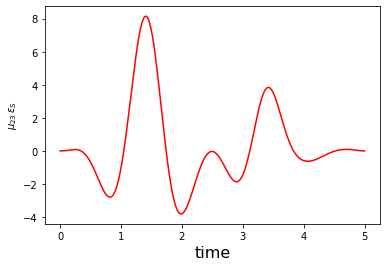Optimization of a Dissipative State-to-State Transfer in a Lambda System¶
[1]:
# NBVAL_IGNORE_OUTPUT
%load_ext watermark
import os
import qutip
import numpy as np
import scipy
import matplotlib
import matplotlib.pylab as plt
import krotov
import qutip
from qutip import Qobj
import pickle
%watermark -v --iversions
numpy 1.17.2
qutip 4.4.1
krotov 0.4.0
matplotlib.pylab 1.17.2
scipy 1.3.1
matplotlib 3.1.1
CPython 3.7.3
IPython 7.8.0
\(\newcommand{tr}[0]{\operatorname{tr}} \newcommand{diag}[0]{\operatorname{diag}} \newcommand{abs}[0]{\operatorname{abs}} \newcommand{pop}[0]{\operatorname{pop}} \newcommand{aux}[0]{\text{aux}} \newcommand{opt}[0]{\text{opt}} \newcommand{tgt}[0]{\text{tgt}} \newcommand{init}[0]{\text{init}} \newcommand{lab}[0]{\text{lab}} \newcommand{rwa}[0]{\text{rwa}} \newcommand{bra}[1]{\langle#1\vert} \newcommand{ket}[1]{\vert#1\rangle} \newcommand{Bra}[1]{\left\langle#1\right\vert} \newcommand{Ket}[1]{\left\vert#1\right\rangle} \newcommand{Braket}[2]{\left\langle #1\vphantom{#2} \mid #2\vphantom{#1}\right\rangle} \newcommand{Ketbra}[2]{\left\vert#1\vphantom{#2} \right\rangle \hspace{-0.2em} \left\langle #2\vphantom{#1} \right\vert} \newcommand{op}[1]{\hat{#1}} \newcommand{Op}[1]{\hat{#1}} \newcommand{dd}[0]{\,\text{d}} \newcommand{Liouville}[0]{\mathcal{L}} \newcommand{DynMap}[0]{\mathcal{E}} \newcommand{identity}[0]{\mathbf{1}} \newcommand{Norm}[1]{\lVert#1\rVert} \newcommand{Abs}[1]{\left\vert#1\right\vert} \newcommand{avg}[1]{\langle#1\rangle} \newcommand{Avg}[1]{\left\langle#1\right\rangle} \newcommand{AbsSq}[1]{\left\vert#1\right\vert^2} \newcommand{Re}[0]{\operatorname{Re}} \newcommand{Im}[0]{\operatorname{Im}} \newcommand{toP}[0]{\omega_{12}} \newcommand{toS}[0]{\omega_{23}}\)
This example illustrates the use of Krotov’s method with a non-Hermitian Hamiltonian. It considers the same system as the previous example, a transition \(\ket{1} \rightarrow \ket{3}\) in a three-level system in a \(\Lambda\)-configuration. However, here we add a non-Hermitian decay term to model loss from the intermediary level \(\ket{2}\).
The effective Hamiltonian¶
We consider the system as in the following diagram:
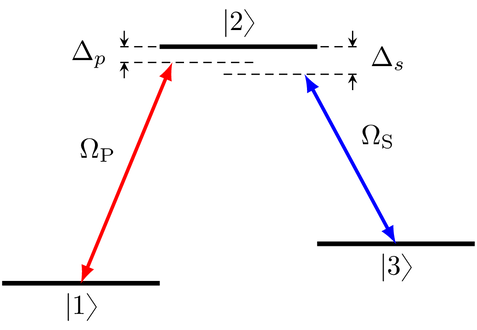
with the Hamiltonian
in the lab frame.
However, we now also include that the level \(\ket{2}\) decays incoherently. This is the primary motivation of the STIRAP scheme: through destructive interference it can keep the dynamics in a “dark state” where the population is transferred from \(\ket{1}\) to \(\ket{3}\) without ever populating the \(\ket{2}\) state. A rigorous treatment would be to include the dissipation as a Lindblad operator, and to simulate the dynamics and perform the optimization in Liouville space. The Lindblad operator for spontaneous decay from level \(\ket{2}\) with decay rate \(2\gamma\) is \(\Op{L} = \sqrt{2\gamma} \Ketbra{1}{2}\). However, this is numerically expensive. For the optimization, it is sufficient to find a way to penalize population in the \(\ket{2}\) state.
Motivated by the Monte-Carlo Wave Function (MCWF) method, we define the non-Hermitian effective Hamiltonian
In explicit form, this is
The only change is that the energy of level \(\ket{2}\) now has an imaginary part \(-\gamma\), which causes an exponential decay of any population amplitude in \(\ket{2}\), and thus a decay in the norm of the state. In the MCWF, this decay of the norm is used to track the probability that quantum jump occurs (otherwise, the state is re-normalized). Here, we do not perform quantum jumps or renormalize the state. Instead, we use the decay in the norm to steer the optimization. Using the functional
to be minimized, we find that the value of the functional increases if \(\Norm{\ket{\Psi(T)}} < 1\). Thus, population in \(\ket{2}\) is penalized, without any significant numerical overhead.
The decay rate \(2\gamma\) does not necessarily need to correspond to the actual physical lifetime of the \(\ket{2}\) state: we can choose an artificially high decay rate to put a stronger penalty on the \(\ket{2}\) level. Or, if the physical decay is so strong that the norm of the state reaches effectively zero, we could decrease \(\gamma\) to avoid numerical instability. The use of a non-Hermitian Hamiltonian with artificial decay is generally a useful trick to penalize population in a subspace.
The new non-Hermitian decay term remains unchanged when we make the rotating wave approximation. The RWA Hamiltonian now reads
with complex control fields \(\Omega_P(t)\) and \(\Omega_S(t)\), see the previous example. Again, we split these complex pulses into an independent real and imaginary part for the purpose of optimization.
The guess controls are
[2]:
def Omega_P1(t, args):
"""Guess for the real part of the pump pulse"""
Ω0 = 5.0
return Ω0 * krotov.shapes.blackman(t, t_start=2.0, t_stop=5.0)
def Omega_P2(t, args):
"""Guess for the imaginary part of the pump pulse"""
return 0.0
def Omega_S1(t, args):
"""Guess for the real part of the Stokes pulse"""
Ω0 = 5.0
return Ω0 * krotov.shapes.blackman(t, t_start=0.0, t_stop=3.0)
def Omega_S2(t, args):
"""Guess for the imaginary part of the Stokes pulse"""
return 0.0
and the Hamiltonian is instantiated as
[3]:
def hamiltonian(E1=0.0, E2=10.0, E3=5.0, omega_P=9.5, omega_S=4.5, gamma=0.5):
"""Lambda-system Hamiltonian in the RWA"""
# detunings
ΔP = E1 + omega_P - E2
ΔS = E3 + omega_S - E2
H0 = Qobj([[ΔP, 0.0, 0.0], [0.0, -1j * gamma, 0.0], [0.0, 0.0, ΔS]])
HP_re = -0.5 * Qobj([[0.0, 1.0, 0.0], [1.0, 0.0, 0.0], [0.0, 0.0, 0.0]])
HP_im = -0.5 * Qobj([[0.0, 1.0j, 0.0], [-1.0j, 0.0, 0.0], [0.0, 0.0, 0.0]])
HS_re = -0.5 * Qobj([[0.0, 0.0, 0.0], [0.0, 0.0, 1.0], [0.0, 1.0, 0.0]])
HS_im = -0.5 * Qobj([[0.0, 0.0, 0.0], [0.0, 0.0, 1.0j], [0.0, -1.0j, 0.0]])
return [
H0,
[HP_re, Omega_P1],
[HP_im, Omega_P2],
[HS_re, Omega_S1],
[HS_im, Omega_S2],
]
[4]:
H = hamiltonian()
We check the hermiticity of the Hamiltonian:
[5]:
print("H0 is Hermitian: " + str(H[0].isherm))
print("H1 is Hermitian: "+ str(
H[1][0].isherm
and H[2][0].isherm
and H[3][0].isherm
and H[4][0].isherm))
H0 is Hermitian: False
H1 is Hermitian: True
Define the optimization target¶
We optimize for the phase-sensitive transition \(\ket{1} \rightarrow \ket{3}\). As we are working in the rotating frame, the target state must be adjusted with an appropriate phase factor:
[6]:
ket1 = qutip.Qobj(np.array([1.0, 0.0, 0.0]))
ket2 = qutip.Qobj(np.array([0.0, 1.0, 0.0]))
ket3 = qutip.Qobj(np.array([0.0, 0.0, 1.0]))
def rwa_target_state(ket3, E2=10.0, omega_S=4.5, T=5):
return np.exp(1j * (E2 - omega_S) * T) * ket3
psi_target = rwa_target_state(ket3)
The objective is now instantiated as
[7]:
objectives = [krotov.Objective(initial_state=ket1, target=psi_target, H=H)]
objectives
[7]:
[Objective[|Ψ₀(3)⟩ to |Ψ₁(3)⟩ via [A₀[3,3], [H₁[3,3], u₁(t)], [H₂[3,3], u₂(t)], [H₃[3,3], u₃(t)], [H₄[3,3], u₄(t)]]]]
Simulate dynamics under the guess field¶
We use a time grid with 500 steps between \(t=0\) and \(T=5\):
[8]:
tlist = np.linspace(0, 5, 500)
We propagate once for the population dynamics, and once to obtain the propagated states for each point on the time grid:
[9]:
proj1 = qutip.ket2dm(ket1)
proj2 = qutip.ket2dm(ket2)
proj3 = qutip.ket2dm(ket3)
guess_dynamics = objectives[0].propagate(
tlist, propagator=krotov.propagators.expm, e_ops=[proj1, proj2, proj3]
)
guess_states = objectives[0].propagate(
tlist, propagator=krotov.propagators.expm
)
[10]:
def plot_population(result):
fig, ax = plt.subplots()
ax.axhline(y=1.0, color='black', lw=0.5, ls='dashed')
ax.axhline(y=0.0, color='black', lw=0.5, ls='dashed')
ax.plot(result.times, result.expect[0], label='1')
ax.plot(result.times, result.expect[1], label='2')
ax.plot(result.times, result.expect[2], label='3')
ax.legend()
ax.set_xlabel('time')
ax.set_ylabel('population')
plt.show(fig)
def plot_norm(result):
state_norm = lambda i: result.states[i].norm()
states_norm=np.vectorize(state_norm)
fig, ax = plt.subplots()
ax.plot(result.times, states_norm(np.arange(len(result.states))))
ax.set_xlabel('time')
ax.set_ylabel('state norm')
plt.show(fig)
[11]:
plot_population(guess_dynamics)
plot_norm(guess_states)
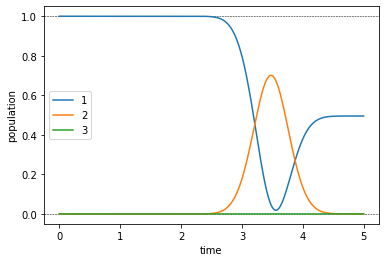
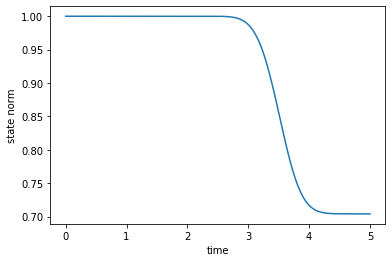
The population dynamics and the norm-plot show the effect the non-Hermitian term in the Hamiltonian, resulting in a 30% loss.
Optimize¶
For each control, we define the update shape and the \(\lambda_a\) parameter that determines the magnitude of the update:
[12]:
def S(t):
"""Scales the Krotov methods update of the pulse value at the time t"""
return krotov.shapes.flattop(
t, t_start=0.0, t_stop=5.0, t_rise=0.3, func='sinsq'
)
[13]:
pulse_options = {
H[1][1]: dict(lambda_a=2.0, update_shape=S),
H[2][1]: dict(lambda_a=2.0, update_shape=S),
H[3][1]: dict(lambda_a=2.0, update_shape=S),
H[4][1]: dict(lambda_a=2.0, update_shape=S)
}
We now run the optimization for 40 iterations, printing out the fidelity
after each iteration.
[14]:
def print_fidelity(**args):
F_re = np.average(np.array(args['tau_vals']).real)
print(" F = %f" % F_re)
return F_re
[15]:
opt_result = krotov.optimize_pulses(
objectives, pulse_options, tlist,
propagator=krotov.propagators.expm,
chi_constructor=krotov.functionals.chis_re,
info_hook=print_fidelity,
iter_stop=40
)
F = -0.007812
F = 0.055166
F = 0.117604
F = 0.178902
F = 0.238507
F = 0.295926
F = 0.350749
F = 0.402648
F = 0.451388
F = 0.496822
F = 0.538882
F = 0.577573
F = 0.612961
F = 0.645161
F = 0.674324
F = 0.700629
F = 0.724268
F = 0.745445
F = 0.764364
F = 0.781226
F = 0.796224
F = 0.809541
F = 0.821349
F = 0.831809
F = 0.841064
F = 0.849250
F = 0.856486
F = 0.862881
F = 0.868532
F = 0.873527
F = 0.877942
F = 0.881847
F = 0.885302
F = 0.888362
F = 0.891074
F = 0.893481
F = 0.895618
F = 0.897519
F = 0.899211
F = 0.900721
F = 0.902071
We look at the optimized controls and the population dynamics they induce:
[16]:
def plot_pulse_amplitude_and_phase(pulse_real, pulse_imaginary,tlist):
ax1 = plt.subplot(211)
ax2 = plt.subplot(212)
amplitudes = [np.sqrt(x*x + y*y) for x,y in zip(pulse_real,pulse_imaginary)]
phases = [np.arctan2(y,x)/np.pi for x,y in zip(pulse_real,pulse_imaginary)]
ax1.plot(tlist,amplitudes)
ax1.set_xlabel('time')
ax1.set_ylabel('pulse amplitude')
ax2.plot(tlist,phases)
ax2.set_xlabel('time')
ax2.set_ylabel('pulse phase (π)')
plt.show()
print("pump pulse amplitude and phase:")
plot_pulse_amplitude_and_phase(
opt_result.optimized_controls[0], opt_result.optimized_controls[1], tlist)
print("Stokes pulse amplitude and phase:")
plot_pulse_amplitude_and_phase(
opt_result.optimized_controls[2], opt_result.optimized_controls[3], tlist)
pump pulse amplitude and phase:
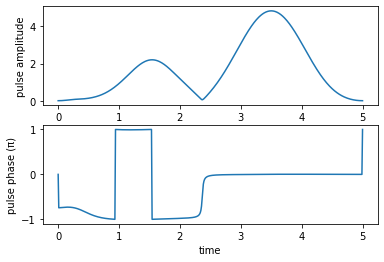
Stokes pulse amplitude and phase:
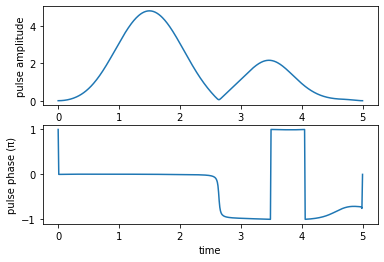
We check the evolution of the population due to our optimized pulses.
[17]:
opt_dynamics = opt_result.optimized_objectives[0].propagate(
tlist, propagator=krotov.propagators.expm, e_ops=[proj1, proj2, proj3])
opt_states = opt_result.optimized_objectives[0].propagate(
tlist, propagator=krotov.propagators.expm)
[18]:
plot_population(opt_dynamics)
plot_norm(opt_states)
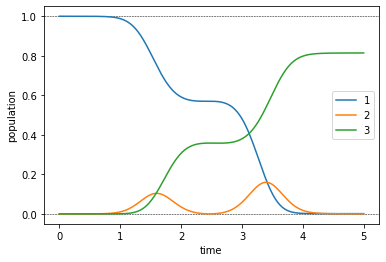
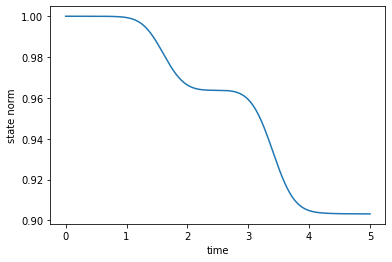
These dynamics show that the non-Hermitian Hamiltonian has the desired effect: The population is steered out of the decaying \(\ket{2}\) state, with the resulting loss in norm down to 10% from the 30% loss of the guess pulses. Indeed, these 10% are exactly the value of the error \(1 - F_{\text{re}}\), indicating that avoiding population in the \(\ket{2}\) part is the difficult part of the optimization. Convergence towards this goal is slow, so we continue the optimization up to iteration 2000.
[19]:
dumpfile = "./non_herm_opt_result.dump"
if os.path.isfile(dumpfile):
opt_result = krotov.result.Result.load(dumpfile, objectives)
else:
opt_result = krotov.optimize_pulses(
objectives, pulse_options, tlist,
propagator=krotov.propagators.expm,
chi_constructor=krotov.functionals.chis_re,
info_hook=krotov.info_hooks.chain(print_fidelity),
iter_stop=2000,
continue_from=opt_result
)
opt_result.dump(dumpfile)
[20]:
print("Final fidelity: %.3f" % opt_result.info_vals[-1])
Final fidelity: 0.966
[21]:
def plot_convergence(result):
fig, ax = plt.subplots()
ax.semilogy(result.iters, 1-np.array(result.info_vals))
ax.set_xlabel('OCT iteration')
ax.set_ylabel('error')
plt.show(fig)
To get a feel for the convergence, we can plot the optimization error over the iteration number:
[22]:
plot_convergence(opt_result)
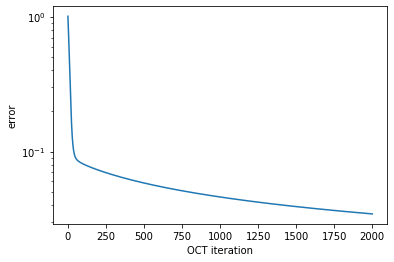
We have used here that the return value of the routine print_fidelity that was passed to the optimize_pulses routine as an info_hook is automatically accumulated in result.info_vals.
We also look at optimized controls and the dynamics they induce:
[23]:
print("pump pulse amplitude and phase:")
plot_pulse_amplitude_and_phase(
opt_result.optimized_controls[0], opt_result.optimized_controls[1], tlist)
print("Stokes pulse amplitude and phase:")
plot_pulse_amplitude_and_phase(
opt_result.optimized_controls[2], opt_result.optimized_controls[3], tlist)
pump pulse amplitude and phase:
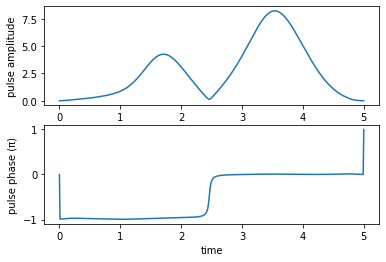
Stokes pulse amplitude and phase:
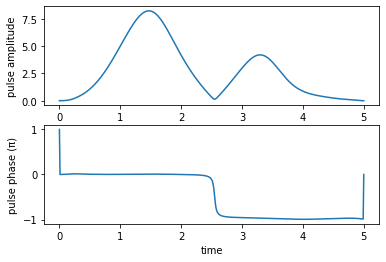
[24]:
opt_dynamics = opt_result.optimized_objectives[0].propagate(
tlist, propagator=krotov.propagators.expm, e_ops=[proj1, proj2, proj3])
opt_states = opt_result.optimized_objectives[0].propagate(
tlist, propagator=krotov.propagators.expm)
[25]:
plot_population(opt_dynamics)
plot_norm(opt_states)
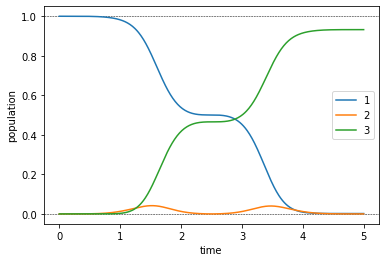
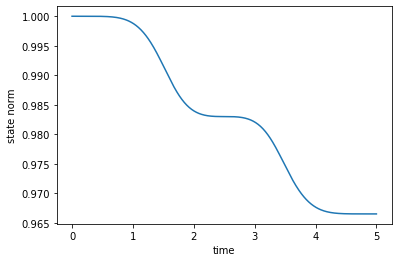
In accordance with the lower optimization error, the population dynamics now show a reasonably efficient transfer, and a significantly reduced population in state \(\ket{2}\).
Finally, we can convert the complex-valued \(\Omega_P\) and \(\Omega_S\) functions to the physical electric fields \(\epsilon_{P}\) and \(\epsilon_{S}\):
[26]:
def plot_physical_field(pulse_re, pulse_im, tlist, case=None):
if case == 'pump':
w = 9.5
elif case == 'stokes':
w = 4.5
else:
print('Error: selected case is not a valid option')
return
ax = plt.subplot(111)
ax.plot(tlist,pulse_re*np.cos(w*tlist)-pulse_im*np.sin(w*tlist), 'r')
ax.set_xlabel('time', fontsize = 16)
if case == 'pump':
ax.set_ylabel(r'$\mu_{12}\,\epsilon_{P}$')
elif case == 'stokes':
ax.set_ylabel(r'$ \mu_{23}\,\epsilon_{S}$')
plt.show()
print('Physical electric pump pulse in the lab frame:')
plot_physical_field(
opt_result.optimized_controls[0], opt_result.optimized_controls[1], tlist, case = 'pump')
print('Physical electric Stokes pulse in the lab frame:')
plot_physical_field(
opt_result.optimized_controls[2], opt_result.optimized_controls[3], tlist, case = 'stokes')
Physical electric pump pulse in the lab frame:
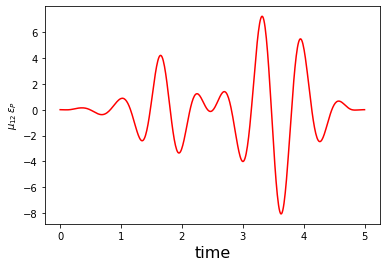
Physical electric Stokes pulse in the lab frame:
